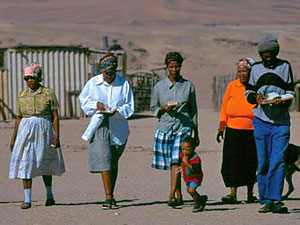|
Indigenous Knowledge: Capturing, Sharing, Networking |
Interest and awareness of the value of indigenous knowledge, particularly its potential contribution to sustainable development, is increasing at a time when such knowledge is being threatened as never before. There are some initiatives underway that try to capture and share traditional knowledge.
| What DLIST users say… “I believe that what is needed, in addition to writing down indigenous knowledge, is a general revival of a sense of inherent worth, value and trust in indigenous communities”.
|
 Platforms where indigenous knowledge is captured, stored and disseminated need to be developed, so as to prevent the erosion of cultural and biological diversity. For the whole process of collecting, applying and disseminating indigenous knowledge, full participation of the local people is required. Platforms where indigenous knowledge is captured, stored and disseminated need to be developed, so as to prevent the erosion of cultural and biological diversity. For the whole process of collecting, applying and disseminating indigenous knowledge, full participation of the local people is required.
ICT could become a very powerful enabler for the exchange of Indigenous Knowledge. This will mainly depend on the local circumstances and the degree of access and connectivity of a country or community.
Local communities can participate in Community-to-community (C2C) exchanges, where they can advance their own development by sharing experiences and learning from each other. Their can do this by building their own capacity to exchange effective indigenous knowledge practices related to agriculture, the environment and healthcare. The C2C exchanges typically try to match knowledge seekers with knowledge providers to help (i) empower the participants to envisage other options (ii) increase the knowledge base of all participants (iii) engage scientists, politicians, and indigenous knowledge practitioners on an equal footing. See the Community Knowledge Exchange Toolkit :
http://www.emg.org.za/documents/IkXchangeToolkits/Toolkit1/intro.htm
Other tools that can be utilised to facilitate the process of indigenous knowledge exchange are:
- Video and radiobroadcasts in local languages could disseminate indigenous knowledge practices using storytelling techniques, especially in rural areas.
- Electronic networking would be most appropriate to establish exchanges among civil society groups and to link existing local indigenous knowledge centres in various countries.
- Telecentres (village knowledge centres) could help make knowledge flow from the local communities outward (indigenous practices) and from the global community inward (international practice).
It has been suggested that the Southern African Development Community (SADC) ultimately needs to develop a traditional knowledge digital library, and have laws developed to prevent such knowledge being misappropriated through commercial patents.
In 2006, the University of Tuléar Madagascar – The French University of the Réunion Island – and the UNESCO published the “Traditional Pharmacopoeia in the Islands of the Western Indian Ocean”. As explained on the DLIST discussions, the book contains 18 interesting papers (in French) about the roles of plants in traditional knowledge. One contribution from Madagascar compares the modern and traditional use of plants by the people of Antongil Bay. Contact Chaplain for more information at ttsiadino@yahoo.com.
You can contribute to UNESCO’s Database on Best Practices related to indigenous knowledge by filling in their questionnaire. By "best practice" they mean an approach (such as a development project or programme, a training method, or an evaluation approach) that has successfully put indigenous knowledge to good use, and/or built upon it for purposes of sustainable development.
Visit http://www.unesco.org/most/bpikques.htm.
|